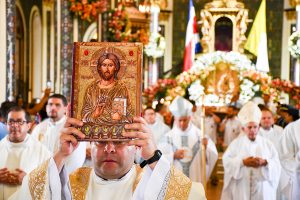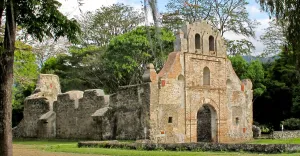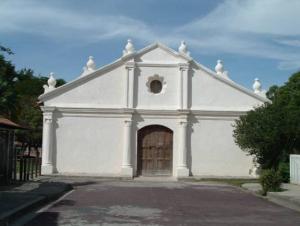Exploring Costa Rica’s Catholic Religious Tapestry from Hotel Hacienda Guachipelin

Catholicism holds a significant place in the cultural, social, and historical fabric of Costa Rica. Costa Rica’s history intertwines closely with Catholicism, dating back to the era of Spanish colonization in the 16th century. The Spanish conquistadors brought Catholicism to the region, and it became the dominant religion.
As you explore Costa Rica, you will come across many churches, cathedrals, basilicas, and religious landmarks that hold historical, architectural, and spiritual importance for Catholics and those visitors interested in local traditions and history. One such tradition is pilgrimages to revered sites, such as the Basílica de Nuestra Señora de los Ángeles in Cartago, which are significant events in the religious calendar.
While Catholicism is the dominant religion, Costa Rica also exhibits religious diversity, with smaller communities practicing other faiths. There’s a blend of indigenous beliefs and customs that have merged with Catholic traditions, creating a unique syncretic religious landscape in different communities around the country. This adds further interest for visitors and is a sign of adaptability that continues to shape the nation’s values and societal norms while coexisting alongside an evolving religious landscape.
Religious Tourism
Religious tourism involves traveling to destinations of religious significance for spiritual, cultural, or pilgrimage purposes. It revolves around visiting places, sites, or landmarks that hold religious importance, allowing individuals to explore, experience, and connect with their faith or spiritual beliefs.
It also encompasses exploring the cultural and historical aspects of a religion. Travelers visit religious landmarks, churches, temples, mosques, shrines, and other sites to understand their historical significance and architectural beauty. And Costa Rica has many to explore and enjoy with a focus on the Catholic religion.
Catholic Religious Tourism in Costa Rica
Catholic tourism in Costa Rica offers a fascinating glimpse into the country’s rich religious heritage. From the Central Valley to Nicoya and Liberia, visitors can explore significant churches, basilicas, and cathedrals, each with its own historical and cultural significance.
Let´s explore some of Costa Rica´s most important Catholic religious sites in Costa Rica, some of which are easily reached from Hotel Hacienda Guachipelin in Guanacaste on the Nicoya Peninsula.
In the Central Valley

The Basilica de Los Angeles is Costa Rica´s most important church.
1. Basílica de Nuestra Señora de los Ángeles
Located in Cartago, the Basílica de Nuestra Señora de los Ángeles, the country´s patron saint, stands as a symbol of faith and devotion in Costa Rica. Its annual pilgrimage every August 2nd, the day of the Virgin, and its historical importance make it a cornerstone of the country’s religious identity. It’s a deeply spiritual experience for pilgrims, many of whom seek blessings, healing, or to fulfill promises made to the Virgin.
For visitors, the Basílica de Nuestra Señora de los Ángeles offers an opportunity to witness the fusion of faith, culture, and history. Exploring the basilica allows guests to admire its architectural beauty, intricate altars, and religious artwork while immersing themselves in the spiritual ambiance that surrounds the site.
2. The Orosi Church
The Orosi Church, officially known as the Iglesia de San José de Orosi, is a significant religious and historical landmark in Costa Rica. Constructed in 1743, the Orosi Church is considered one of the oldest churches in Costa Rica and has served as a place of worship and spiritual center for centuries for residents and visitors alike. It stands as a testament to colonial architecture, reflecting the Spanish influence prevalent in the country’s history.
The church’s construction is characterized by adobe walls, white stucco exteriors, and a red-tiled roof, typical of colonial-era architecture. The church’s interior is adorned with religious artwork, ornate altars, and antique religious artifacts, offering a glimpse into Costa Rica’s religious heritage.
The Orosi Valley offers a serene setting for exploration, with lush greenery, coffee plantations, and the nearby Tapantí National Park, providing opportunities for nature walks, hikes, and immersion in Costa Rica’s natural splendor.

The Ruins of Ujarras in Cartago. Photo Credit: Municipalidad de Paraíso
3. The ruins of the Temple of Ujarrás
The Ruins of Ujarrás hold significant historical and cultural importance in Costa Rica, attracting pilgrims and tourists alike. The Ruins of Ujarrás are the remnants of the oldest church in Costa Rica, built in the 16th century. Located in the Orosi Valley, this site was once home to the Parish of Santiago Apóstol of Ujarrás.
Ujarrás was established during the Spanish colonization era and played a vital role in the religious and social life of the surrounding communities. Unfortunately, various natural disasters and earthquakes over time led to the church’s eventual abandonment in the 18th century, leaving behind the picturesque ruins that stand today.
The picturesque Ruins of Ujarrás hold a special place in Costa Rican culture, drawing pilgrims from different parts of the country and even abroad. The most notable is the annual pilgrimage held on April 25th to honor Santiago Apóstol, the church’s patron saint.
In Guanacaste

The San Blas Church in Nicoya in Guanacaste
-
San Blas Church in Nicoya
In Nicoya, the Iglesia de San Blas stands out as a symbol of colonial-era architecture. Its simple yet elegant design captures the essence of the region’s religious heritage. Visitors can appreciate its historical significance and serene atmosphere. It is a cultural treasure steeped in history, embodying the colonial legacy of Costa Rica.
Built during the 16th century, the Iglesia Colonial de San Blas stands as one of the oldest churches in Costa Rica. The church’s design combines simplicity with colonial charm, featuring whitewashed walls, an adobe structure, and a traditional bell tower.
For guests at Hotel Hacienda Guachipelin, a visit to the Iglesia Colonial de San Blas is a two-hour drive away. This religious and cultural one-day tour offers a chance to immerse themselves in Costa Rica’s history, appreciate the town of Nicoya’s cultural vibrancy, and witness the historical legacy preserved within the walls of this colonial-era church. It’s an opportunity to explore the past and present of a town steeped in tradition and heritage.

The Hermitage of Our Lord of Agony in Liberia
Photo Credit: Municipalidad de Liberia
2. The Hermitage of Our Lord of Agony in Liberia
Liberia boasts the Hermitage of Our Lord of Agony, a quaint church with a fascinating history. Its unique blend of architectural styles reflects the cultural diversity of the region, attracting tourists interested in both religious and historical exploration. It holds a special place in Liberia’s history, dating back to the 19th century. Constructed in the colonial style, the church stands as a testament to the region’s religious heritage and architectural legacy.
Its modest yet charming structure exudes a sense of historical reverence. Beyond its religious significance, the hermitage stands as a cultural landmark in Liberia. It represents a piece of the town’s history and identity, offering visitors a glimpse into the traditions and customs that have shaped the region.
For guests at Hotel Hacienda Guachipelin, a visit to the Hermitage of Our Lord of Agony is a 30-minute drive away. During your visit to the “White City”, can also explore Liberia’s vibrant town center, where the church is situated. Liberia boasts a rich cultural scene, with artisan markets, local eateries, and a welcoming community eager to share its history.
Upon returning to the hotel after a day of exploration, guests can unwind in the serene surroundings of Hacienda Guachipelin, reflecting on their experiences while enjoying the comfort and hospitality provided by the hotel.
Embarking on a Catholic tourism journey can be both spiritually enriching and culturally immersive. Exploring these revered sites offers insight into Costa Rica’s religious roots and the fusion of faith with the country’s history and identity.
Whether it’s witnessing the devout pilgrims at Basílica de Nuestra Señora de los Ángeles or admiring the architectural beauty of San Blas Church, Catholic tourism in Costa Rica offers a unique way to connect with the country’s spiritual heritage.
For guests at Hotel Hacienda Guachipelin, a Catholic tourism journey through Costa Rica promises a blend of spiritual enrichment and cultural exploration. It’s an opportunity to appreciate the beauty of faith and history while indulging in the comfort and tranquility of the hotel’s hospitality.
